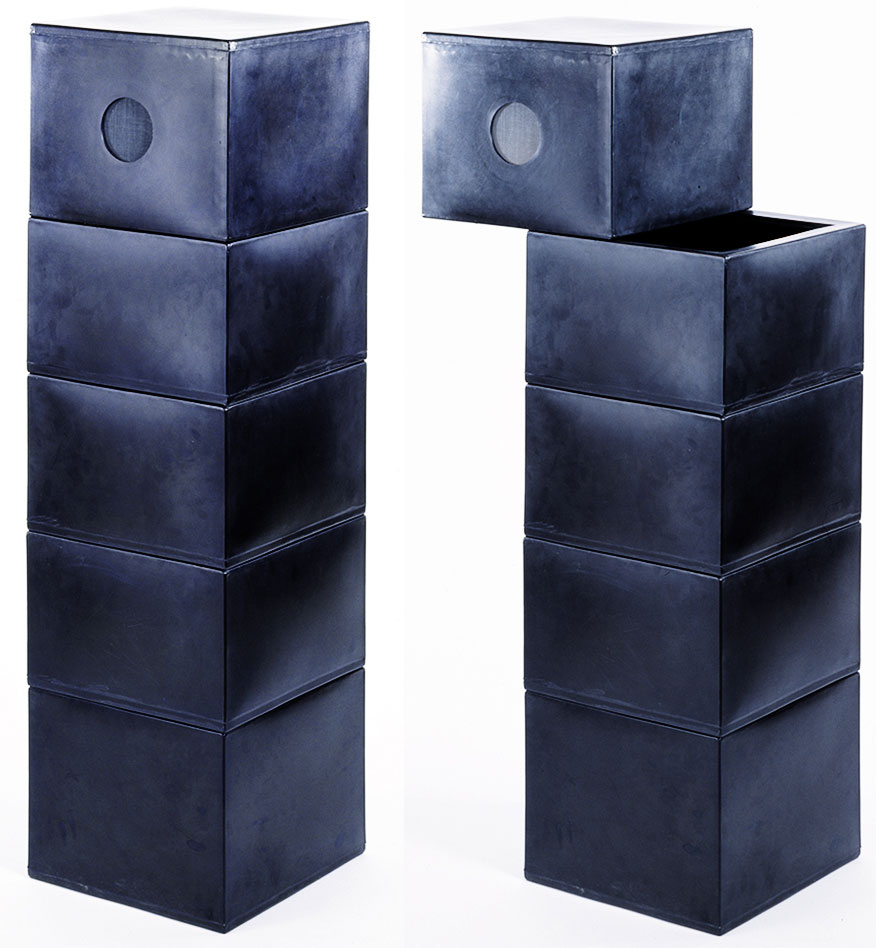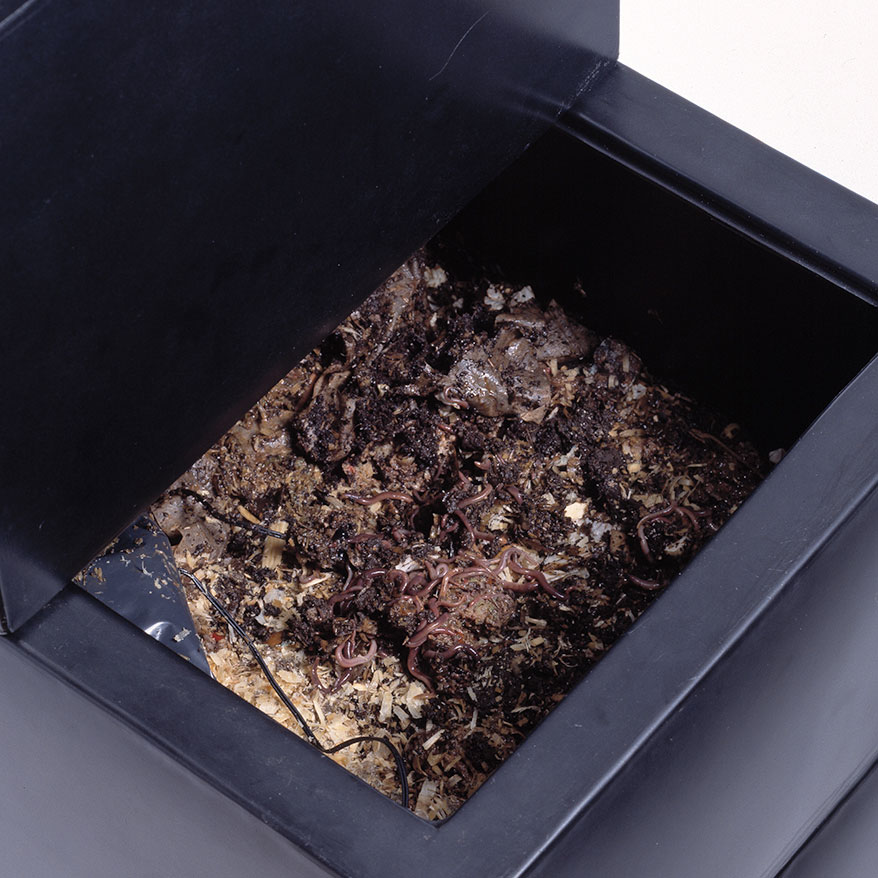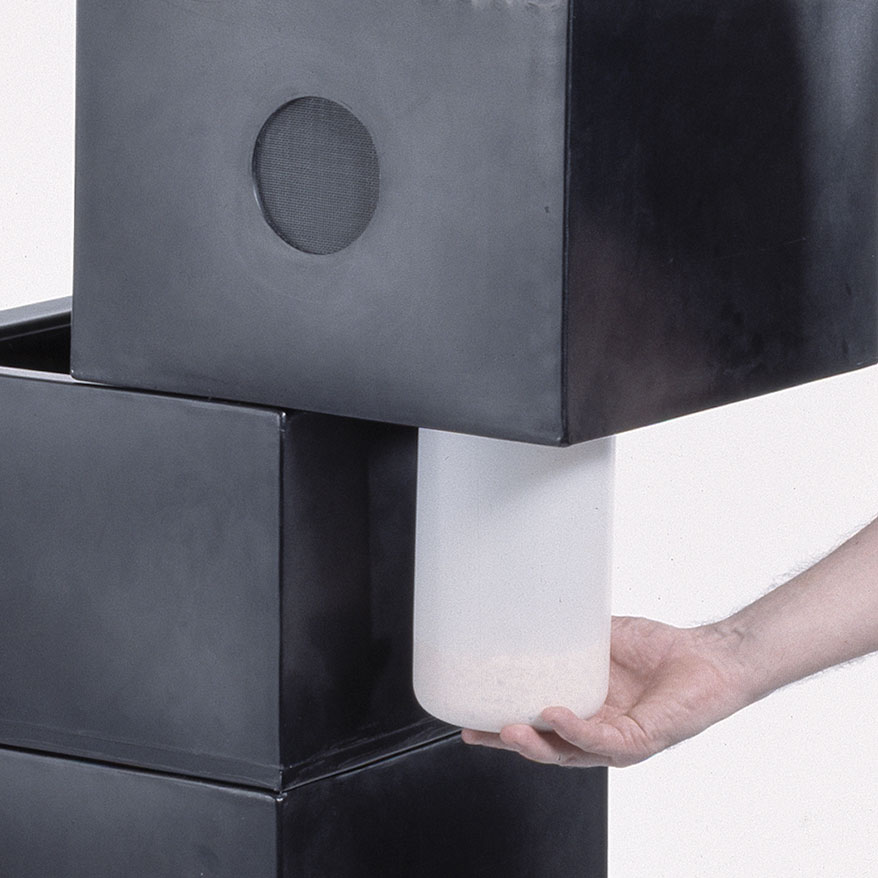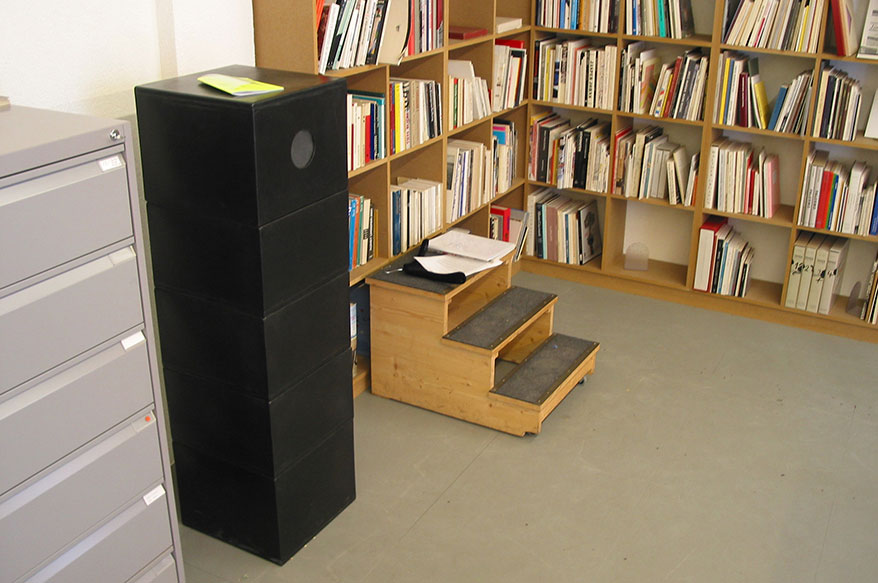Manual for
SOIL FACTORY
 SOIL FACTORY, 1998
SOIL FACTORY, 1998
Introduction:
The SOIL FACTORY enables persons to produce their own soil. By the process
of vermicomposting the organic waste of a small household (3-4 persons)
is effectively transformed, leaving a highly fertile substance. The system
is made for indoor use.
Technical background:
A person living in a city produces approximately 100 kg of organic household
waste per year. By using this material in the SOIL FACTORY or similar systems,
it can be transformed into soil. Although it is not the most effective system,
vermicomposting is a simple and cheap way of composting. The decomposition
is done partly by worms, partly by other organisms and microbial processing.
The worms´ digestive tracts perform efficient microbial and chemical
transformation, and their activities provide the mechanical work also necessary
for the composting process: mixing, draining and aeration
System components:
The SOIL FACTORY consists of three main modules: 1) The top module, through
which the system is ventilated and supplied with raw material and bedding.
It keeps out light and reduces odour inconveniences. A thermometer, a fly
trap and a container for bedding is mounted on the inside. 2) The middle
module, consisting of three tanks containing the worms, the raw material
and the resulting product. 3) The bottom module, which collects excess fluid.
The composting process is initiated by putting approximately 1000 worms
and some organic material into the upper tank of the middle module. When
this tank is full, it is exchanged with the next empty tank in the column.
The three tanks are all perforated in the bottom to allow excess water to
pass through to the bottom module. This is done in such a way that the worms
will also be able to move upwards in the system
As the worms process the material, they will move to the top layers where
there is access to fresh raw material. When the tanks are full, they should
be allowed to rest for some time in order to complete microbial and worm
processing and to allow the worm cocoons, which are placed in the deep layers,
to be hatched.
After approximately 6 months, the material in the lowest tank is transformed
into a black, soft substance mostly consisting of worm castings, a large
part of which is humus.
Some of the material will be the product of bacterial consumption, and there
will also be occasional residues, which have not been degraded. This substance
can then be mixed with sand, peat, gravel etc. for ventilation and volume
and in order to lower the concentration of nutrients. One has now produced
good nutritious soil. The drained water in the bottom module is also highly
nutritious for plants.
Biological processes:
Shortly after adding raw material, moulds and fungi appear on the surface
and pre-process the material before bacteria and worms take over. Apart
from these, beetles, mites, flies, nematodes, snails, springtails, woodlice
and other species may be present in the composting modules. The number of
species present depends on many factors, such as the age, humidity, temperature
and composition of the material and the access to the composting modules.
Anaerobic bacteria may thrive in the material if it gets too dense and therefore
is not thoroughly ventilated. Pathogenic bacteria normally will not survive
in the compost as the environment simply favours the growth of other bacteria,
which oust the pathogens.
The composting process is finished when the raw material has been processed
into worm castings and the microbial activity has stagnated

|
 |
SOIL FACTORY. A container for the bedding is mounted
inside the top module. The bedding, which is added together with the raw
material, contributes by optimising the C/N relationship.

Worms:
Many different types of worms can be used in composting processes. Eisenia
Foetida, which is the worm used in this system, is among the soil-surface-dwelling
or compost-preferring species. These species prefer to live at or near the
soil surface or in compost heaps, since they like to eat material which
is high in organic matter
The worms are hermaphrodites, producing both sperm and eggs, but are dependent
on each other for reproduction. They reproduce by joining mucus from their
clitella, exchanging sperm. The mucus hardens into a cocoon where sperm
and eggs are deposited, whereupon the worm backs out of the hardening cocoon.
After being released from the worm, the cocoon closes at both ends, and
2-10 eggs are fertilized
Approximately 2-3 baby worms are hatched after 3 weeks. After 9 weeks, the
new worms are fertile, and under optimal conditions they will produce 2-3
cocoons per week for 6-12 months
The full-grown worms weigh approx 0.5 grams and consume approximately half
their weight of material each day
The average lifespan of the worms in a functioning vermicomposting system
is 3-4 years.
Composting parameters:
Ventilation
Vermicomposting is an aerobic combustion process which is dependent on constant
access to oxygen. A lack of oxygen may result in anaerobic processes, which
produce inconvenient smells. The worms make tunnels in the material providing
oxygen supply and allowing CO2 to escape. This is also important for the
bacterial processes. If the material gets too dense, or the tank is too
deep, these tunnels collapse. The surface of the material should be exposed
to air, but loosely covered by e.g. a black plastic sheet. This is to protect
the worms from UV-radiation, in which they can not survive more than a few
minutes
Temperature
The worms thrive and breed optimally in a temperature between 15-25 degrees
Celsius. They can survive temperatures between 0-40 degrees. The proportion
of worms/bacteria is decisive to the temperature, and a large bacterial
population may cause temperatures lethal to worms. This is normally not
a problem, as worms dig through dense areas and create ventilation ducts
in the material, whereby the temperature is reduced. Good living conditions
for worms will normally keep bacterial populations down
Humidity
The vermicomposting process depends on a good humidity balance. If the material
becomes too wet, the worms may drown, but the worms need moisture in order
for the air exchange to take place through their skin. Therefore the compost
must not dry out. The water contained in normal kitchen waste, together
with some dry bedding, ought to ensure a good moisture balance. If the compost
should become too dry, some water can be added. As long as water is condensed
on the inside of the covering plastic sheet, the compost is moist enough.
Ph
The worms thrive at a neutral pH value of 6-7. If the pH gets too low, a
calcareous product could be carefully added.
Raw material
All kinds of organic waste can be added to the SOIL FACTORY, although one
must make sure that the material is not toxic or corrosive etc. Fruit, vegetables,
coffee grounds, teabags, egg shells, bread, dairy products, paper, cardboard,
coffee filters etc., are all suitable. Fish, shellfish and meat may cause
severe odour inconveniences. Plastic and metals must be avoided, as it is
normally not degraded in the compost and may be toxic. One must also be
careful adding sauce or soup, which may disturb the humidity balance.
The material could be cut or ground before it is put into the SOIL FACTORY,
as this eases the transformation process
C/N proportion
The Carbon/Nitrogen proportion is essential to the composting process. If
the amount of carbon is high in relation to the amount of nitrogen the process
slows down. If the share of nitrogen gets too high, there is a risk of ammonia
appearing in the compost. Bacteria and worms thrive optimally at a C/N proportion
of 25:1. Kitchen waste normally has the proportion of C/N 15:1 and therefore
one should add material containing carbon.
Bedding
The bedding, which is added together with the raw material, contributes
by optimising the C/N relationship. It also regulates humidity and helps
ventilate the compost by preventing it from becoming too dense. The bedding
must be rich in carbon, toxin free and fit to absorb moisture. Shredded
paper, cardboard and newspaper, leaf mould, peat moss and sawdust can be
used. One must make sure that the sawdust comes from untreated wood, as
otherwise it may contain toxic substances.
Problems:
Common problems in indoor composting are fruit flies and inconvenient smells.
Both problems result from an unbalanced process: erroneous humidity control,
lack of bedding, the wrong bedding, or an overload of raw material which
may cause anaerobic processes to take place
Installation:
Installation of the system is easy and requires no use of tools
Maintenance:
Fresh raw material should be added every week. 1000 worms consume approx
0.25 kg of raw material each day. The worms can be left alone for up to
three weeks, but in order to keep up the population they should be fed on
a regular basis. The volume of the kitchen waste is greatly reduced by the
process. One composting tank is normally filled up after 2 months. When
all three tanks are full, the process in the lower tank is completed, and
the tank can be emptied.
Extra equipment:
A grinding mill can be attached to the top module for easy comminuting of
the raw material. The system can be insulated for outdoor use.
Component list:
1000 pc composting worms (Eisenia Foetida)
2 pc black PE tanks 40 x 40 x 30 cm
3 pc black PE tanks w. socket, 40 x 40 x 30 cm, with 36 pc holes Ø
18 mm
2 pc stainless acid-resistant steel fittings for mounting of top module
Fly trap: polypropylene tank, 3 liters with hole Ø 2.4 mm, beer or
wine
Bedding container: polypropylene tank, 3 liters, sawdust
Fly net
Black plastic sheet for covering.
 |
|
| SOIL FACTORY, Switzerland 2002 |
|
|
Back to manuals
Back to HOME
 SOIL FACTORY, 1998
SOIL FACTORY, 1998


